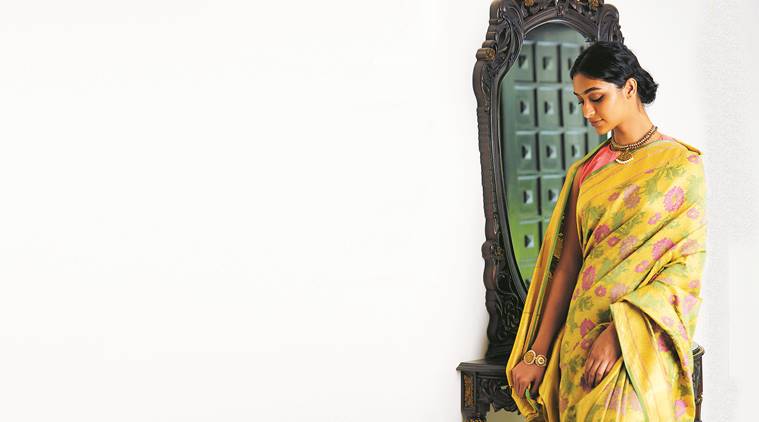
FOR Kolkata-based Swati Agarwal and Sunaina Jalan, the sari has always been more than just a six-yard sartorial statement. They’ve variously called their handloom explorations a labour of love, a passion project, even an academic obsession. Since the sisters-in-law officially launched their eponymous label Swati & Sunaina in 2015 they’ve been known for creating exemplary real zari saris. Woven with 98.5 per cent purity of silver with gold plating, their limited edition creations have aimed at becoming heirloom pieces for textile connoisseurs. And with their latest collection“Between land and the sky, woven gold from Gyaser tradition” on exhibit at Gallery Maskara in Colaba, Mumbai, they’ve taken a step closer to elevating their craft to the level of high art.
Presented by art collector Czaee Shah, curated by anthropologist Monisha Ahmed and with scenography by Mayank Mansingh Kaul, the collection sees Swati & Sunaina work with the unique Gyaser brocade textiles that weave together the trade, handloom and aesthetic links between the Buddhist Himalayas, China and Banaras. Or as the knowledgeable group of collaborators call it “the other silk route”.
Enamoured by the colours, heft, vibrancy, luminous quality and even richer history behind the Gyaser weave — a silk brocade fabric patterned with auspicious Buddhist and Chinese symbols, largely used for ceremonial and devotional purposes — the duo first remembers collecting pieces of the fabric for their private collection. Jalan remembers her wedding lehenga being made of Gyaser brocade nearly 25 years ago. “We’ve always wondered how we could innovate with the thick Gyaser fabric and create something that can be draped as a sari. In its pre-existing thickness and traditional 25-inch width format it was too stiff and could only be used for apparel and ceremonial drapes,” says Jalan.
What started as an academic exploration in late 2017 took several months of research and development. “The challenge was to increase the loom size to 45-inch width, which is needed for a sari. We reduced the weight of the weave and changed its construction in order to make it supple, which we managed to do successfully after researching for nearly seven months. And all this while retaining the inherent look of the fabric, which has the rich sheen of satin,” explains Jalan.
Swati & Sunaina drew from the rich smorgasbord of Gyaser motifs and colours, eschewing the more traditional dragons, clouds and thunderbolts in favour of flowers like chrysanthemums, lotus and roses. “The zari normally used in the Gyaser is a brighter gold than the shade we have used in our previous collections. So, we electroplated our 98.5 per cent silver with 24-carat gold of a deeper hue,” she says. Design explorations came in the form of placement of borders and pallus since traditional Gyaser textiles have neither. And with each sari taking in the vicinity of three to five months to weave alone, each promises to be a collector’s item. “Six designs have been created and 12 pieces of each design will be woven. Of the 72 pieces conceived for this collection, 50 have already been woven and 32 are still in process,” says Jalan, explaining the craft and labour-intensive process.
No wonder, the duo doesn’t look at their creations merely as commercial products. A museum-like display at Gallery Maskara gives it the preponderance it deserves. “Ours is a small, niche and academic business. And the emphasis has always been on archiving and preserving the craft. As it is, with master weavers being few and far between and with the younger generation not interested in taking up their family trade, in a few years such work will be in the museums,” says Jalan.
The exhibition will be on view till April 20 at Gallery Maskara, Apollo Bunder, Colaba, Mumbai